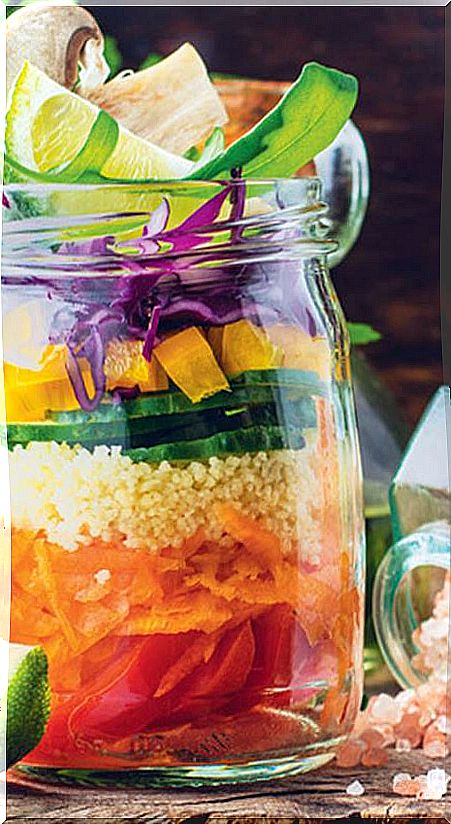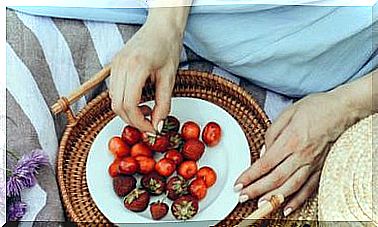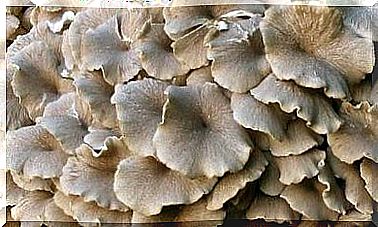Vertical Salads That Take Care Of You Inside
Taste and health are multiplied by ten in these original and practical salads thanks to the fact that, with fermentation, abundant probiotics are generated.

Fermented, sprouts, green juices, kefir … they promote the proliferation of beneficial microorganisms in our intestines and are part of what we call “symbiotic nutrition”. This type of diet will do a lot for us, starting with our intestinal health.
When fermenting a food we multiply the contribution of beneficial microorganisms. From the appropriate vegetables and through the use of a small amount of salt, symbiotic foods are obtained that, if consumed regularly, promote optimal health maintenance. In the world and since ancient times, this type of food has been elaborated in an artisanal way.
Live foods: probiotics and much more
In addition to the fermented or probiotics themselves, there are a number of foods that are part of symbiotic nutrition:
- The sprouts are very interesting, since we can work out at home. By eating them fibers and microorganisms are obtained that facilitate intestinal transit and digestion, in addition to the nutrients of the seed.
- The fresh vegetables and raw also contain beneficial microorganisms. This is one of the great advantages that natural and ecological products have over chemically treated ones, which lack these living elements or provide them at a very low rate.
- The seeds, like those of flaxseed and chia, provide different types of fiber, soluble, insoluble and mucilage, which benefit the intestinal microbiota.
- Seaweed such as agar agar are added to all kinds of smoothies, yogurts and vegetable cheeses, hors d’oeuvres, salads, rice dishes, etc. Given their high concentration of nutrients, they provide an unusual richness over the traditional diet.
- The green smoothies, with a high power antioxidant, have become fashionable among many people who want to care for their health. To make them, they ideally require cold pressure extractors, instead of the classic blenders, so as not to deteriorate the most delicate micronutrients. If these shakes are left to ferment for a day or two with the liquid from the sauerkraut or rejuvelac, then the nutritional value multiplies exponentially.
Make them yourself
The symbiotic food has a high component of “do it yourself and share it with your friends.” In Spain there is no great culture of fermented foods. Therefore, the person who follows this way of eating must learn to process a large part of the food that he is going to consume, becoming at the same time a producer and consumer or pro-consumer.
This is an added value that gives the food we eat the power of our attention and love. And since many of these foods (like kombucha, water kefir …) multiply and grow, it is necessary to give away a part of the probiotic cultures if we do not want to throw them away. In this way, exchange relations are generated between people, where the value of money is not associated with food.
How to make them
Whether we cook –always at the lowest possible temperature– or if we eat raw or make symbiotic recipes –such as fermented vegetables– we must choose fresh and healthy products, and use them as quickly as possible to prevent them from becoming devitalized.
The main recommendation is to start with easy recipes and progress as the palate gets used to the new textures and flavors.
The salad for the whole week that we show you below, and the variants that can be obtained from it, is a good example.
Recipe: Pressed salad for the week
Preparation time 20 min.
Ingredients
- Cabbage
- Carrot
- Turnip
- Kohlrabi
- Onion
- Lombarda
- Broccoli
- Celery
- Fennel
- Sea salt
Preparation
- Cut the vegetables into thin strips and add enough salt to make it tasty to taste. Stir well to distribute the salt. Grate the roots and do the same. The salt will gradually extract the lactic acid that produces the regenerating microorganisms.
- Put everything in a salad bowl and squeeze it by hand. Place a plate on top that presses the vegetables. Cover with a cloth and store at room temperature.
- Eat a little each day and save the rest. From the third day you can put it in glass jars, without the need for refrigeration.
- Over the days, the amount of microorganisms that will keep the vegetables healthy and crisp increases, making them a little more acidic each time.









